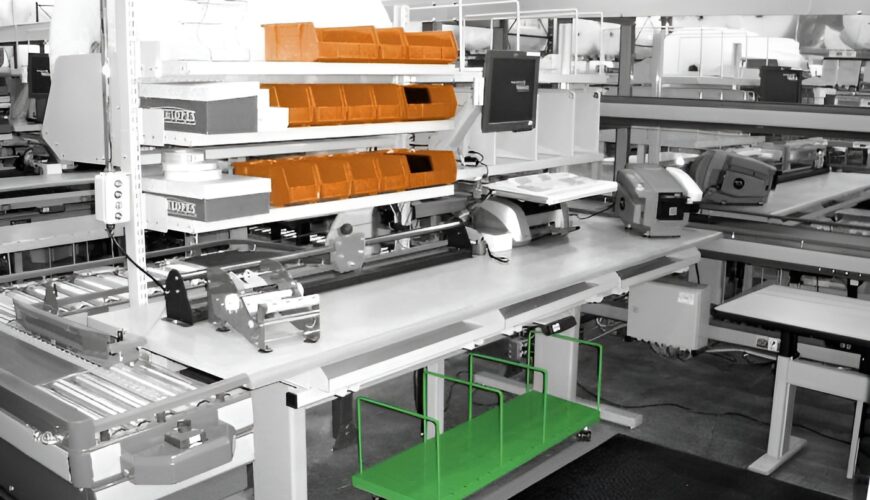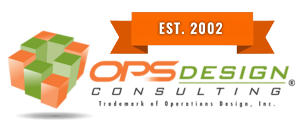Well-engineered workstations harmonize process optimization, digital system integration, infrastructure flexibility, and labor efficiency. In modern supply chain operations, the demand for agility, customization, and value-added fulfillment continues to grow. Activities such as labeling, kitting, repackaging, and light assembly have evolved from peripheral services into core competencies for distribution centers striving to meet diverse customer requirements. These operations—collectively referred to as value-added services (VAS)—require far more than just space allocation and labor deployment.
As a supply chain consulting firm with decades of experience supporting Fortune 500 and mid-market clients, we have found that improperly designed workstations often serve as the hidden bottlenecks that inhibit productivity, quality, and throughput. Conversely, when designed strategically, workstations serve as powerful enablers of operational excellence.
This article outlines our methodology for designing highly efficient workstations for value-added services, kitting, and light assembly operations within warehouse environments. We address optimal process engineering, system support, infrastructure considerations, and labor efficacy—all foundational pillars for success.
Operational Context: Understanding the Scope
Workstations supporting VAS, kitting, and light assembly must accommodate diverse workflows, products, and customer-specific requirements. While each operation type is unique, they share a common set of design objectives: consistency, accuracy, safety, and throughput.
Value-Added Services (VAS)
VAS activities such as labeling, tagging, price marking, shrink wrapping, and repackaging are often driven by retail, compliance, or marketing requirements. These services must be executed with precision and speed—often under time-sensitive conditions.
Kitting
Kitting involves the pre-assembly of multiple SKUs into a single sellable unit or deployment-ready kit. The process may include sequencing, bundling, verification, and packaging, all of which must be executed with care to avoid quality issues or fulfillment delays.
Light Assembly
Light assembly encompasses operations such as component fastening, minor wiring, custom fitting, and bundling. While not as complex as traditional manufacturing, these tasks often involve tools, fixtures, and multi-step procedures that must be engineered for efficiency.
At the center of each of these activities lies the workstation—the primary point of labor execution, quality control, and value creation.
Process Engineering: Designing for Efficiency
Our firm begins every workstation design project with a rigorous process engineering phase. This ensures that workstations are designed to support optimal task flow and eliminate inefficiencies before infrastructure decisions are made.
Task Decomposition and Work Content Analysis
We begin by analyzing each task using time-and-motion studies and process mapping. Activities are broken into elemental steps and categorized by:
• Value-added time
• Non-value-added time
• Waste (e.g., walking, waiting, rework)
This analysis serves as the foundation for identifying layout needs, material presentation, and equipment selection.
Takt Time and Line Balancing
For multi-station operations (particularly in assembly environments), we conduct takt time analysis to define the production rhythm required to meet demand. Work content is then balanced across stations to eliminate bottlenecks and ensure smooth process flow.
Waste Elimination and Lean Integration
Applying Lean principles—5S, standard work, and Kaizen—we identify and remove non-value-added activities. The goal is to design stations where:
• The right materials are within reach
• Operator motion is minimized
• Task sequence flows logically
• Mistake-proofing mechanisms are embedded
Workstations are not an afterthought—they are engineered as extensions of a well-structured process.
System Support: Enabling Digital Execution
System integration is essential to ensure that operators receive the right instructions, materials, and feedback at the right time. Our firm ensures that workstations are digitally enabled for optimal visibility, traceability, and accuracy.
Warehouse Management System (WMS) Integration
We configure the WMS to direct and confirm workstation tasks through RF, pick-to-light, voice, or touchscreen terminals. This digital oversight ensures compliance with process standards and prevents manual errors in kitting, labeling, or light assembly.
Warehouse Control System (WCS) Support
When workstations are embedded in a mechanized or automated environment, the WCS coordinates product flow to and from the workstation. This includes conveyor routing, sortation, buffering, and material staging.
Manufacturing Execution System (MES) Interface
For light assembly operations with traceability or quality requirements, MES integration allows for real-time data capture, procedural validation, and quality tracking.
Error-Proofing and Decision Support
Digital tools—barcode scanning, RFID, visual instructions, image capture, and checklists—are implemented to validate inputs, prevent errors, and support high first-pass yield.
Our firm works with clients to ensure that workstation-level systems are intuitive, actionable, and seamlessly integrated into the broader warehouse ecosystem.
Infrastructure Design: Building the Right Workstations Environment
Modular Workstation Framework
We recommend modular workstation systems that can be reconfigured as work content evolves. Essential components include:
• Adjustable-height work surfaces for ergonomic flexibility
• Task lighting to reduce eye strain and improve accuracy
• Tool mounting systems to keep devices within reach
• Integrated storage for parts, documents, and supplies
• Power/data access points to support tools and digital devices
• Pack-out and labeling stations for post-process handling
Each element is selected to support specific task requirements, user preferences, and future scalability.
Material Presentation and Flow
Using flow racks, conveyors, or mobile carts, materials are presented to the operator in a consistent left-to-right (or mirrored) direction. High-frequency items are positioned at the optimal ergonomic height (waist to shoulder), while lower-use components are stored above or below the primary reach zone.
Fixtures, Tooling, and Work Aids
Custom fixtures and jigs improve repeatability, reduce setup time, and minimize variation. Tools are mounted on swing arms, trolleys, or vertical slides to reduce strain and accelerate access.
Layout Planning and Space Utilization
Workstations are spaced for task flow, safety, and visibility. Where appropriate, we engineer:
• U-shaped cells for multi-task operators
• Linear lines for high-volume assembly
• Pods or clusters for team-based VAS execution
Floor layouts are designed with scalability, access, and flow in mind.
Labor Optimization: Enhancing Productivity and Safety
Ergonomic Design Standards
Workstations are designed to accommodate a wide range of operator sizes and capabilities. We engineer for the 5th percentile female to the 95th percentile male, using adjustable platforms, anti-fatigue mats, and tilt mechanisms where appropriate.
Job Design and Rotation
To prevent repetitive strain injuries and maintain engagement, we develop rotational job roles across complementary workstations. SOPs and cross-training plans are part of our standard deliverables.
Operator Engagement and Feedback
We actively engage client employees—especially frontline associates, workstation trials and design reviews. Their insights inform the refinement of tool placement, work surface height, and visual instruction formats.
Visual Work Instructions and SOPs
Every workstation is equipped with clearly defined standard work procedures and visual cues. These materials support consistent task execution, reduce onboarding time, and minimize variability across shifts.
Metrics, Scalability, and Continuous Improvement
KPI Development and Monitoring
We help clients define and measure key performance indicators, including:
• Throughput per station and per operator
• Defect rates / first-pass yield
• Labor productivity and utilization
• Setup and changeover time
• Cost per processed unit
Dashboards and real-time displays reinforce performance visibility and accountability.
Continuous Improvement Framework
We embed a culture of continuous improvement through:
• Gemba walks to observe live operations
• 5S audits to ensure organization and cleanliness
• Kaizen events to identify and implement quick wins
• Root cause analysis to resolve recurring issues
Our firm also provides post-implementation reviews to identify opportunities for reoptimization as volumes and requirements evolve.
Scalability and Reconfiguration
Workstations are designed to scale with volume. Modular components, standardized utilities, and interchangeable fixtures support:
• Seasonal flexing
• New product introductions
• Line expansion or contraction
We advise clients to plan for growth—not just current-state performance—by engineering infrastructure with agility in mind.
Flow Integration: Material Handling Upstream and Downstream
Inbound Material Delivery
To prevent workstation starvation, we design feeder systems that ensure timely delivery of components and packaging materials. This may include:
• Pallet jacks or tuggers
• Mobile batch carts
• Gravity flow racks
• AMRs for point-of-use replenishment
Post-Process Material Handling
Completed kits, assembled products, or relabeled items must flow downstream efficiently. Options include:
• Conveyors to packing or shipping
• Cart-based transfer to QC
• Buffer zones for WIP or staging
• Direct integration with sortation systems
Flow integration ensures that workstations do not become isolated islands but are part of a synchronized, end-to-end fulfillment process.
Avoiding Common Design Failures
Based on our extensive project experience, we caution clients to avoid these common pitfalls:
• Over-customization: Avoid building workstations for one SKU or process. Flexibility is key.
• Lack of pilot testing: Always prototype and test workstations with real operators and real tasks.
• Ignoring ergonomics: Poor ergonomic design leads to injuries, inefficiencies, and turnover.
• Neglecting flow integration: Workstations must be part of a broader system—not standalone entities.
• Underestimating training: Even the best-designed station fails without thorough and ongoing training.
Strategic Importance of Well-Designed Workstations
Workstations are often overlooked during warehouse design initiatives, relegated to the end of the project as a secondary consideration. We challenge that mindset.
In the context of VAS, kitting, and light assembly, workstations are not peripheral; they are core to the operation’s value proposition. They influence labor productivity, product quality, customer satisfaction, and operational agility.
Investing in the intelligent design of these work areas pays long-term dividends in throughput, cost control, labor retention, and service reliability.
Conclusion
As a consulting firm specializing in warehouse optimization and distribution engineering, we view workstation design as a critical discipline—one that bridges the gap between strategic intent and operational execution.
In VAS, kitting, and light assembly environments, the workstation is where value is created, customization is achieved, and differentiation occurs. When designed with purpose—guided by process engineering, system integration, ergonomic best practices, and scalable infrastructure—these workstations enable superior operational outcomes.
For organizations seeking to modernize their fulfillment capabilities or introduce value-added services, workstation design is not a detail to be delegated. It is a strategic imperative—and one that must be executed with the rigor, precision, and insight of experienced supply chain engineering professionals.


